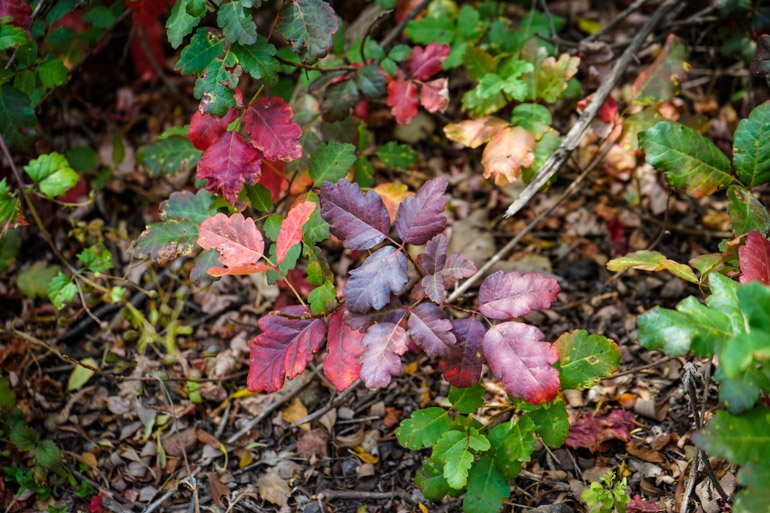
Fellow hikers and adventurers behold! This is poison oak! For the longest time I had no idea what poison oak looked like. Is it green or red? How many leaves does it have? If my hiking pants touch it, can I get infected? I’m sure questions like these have crossed the minds of many a hiker. Well I’ve finally taken the time to learn about this plant and mainly how to avoid it while wandering through the great outdoors.
What is Poison Oak?
For all the hiking I’ve done, it’s safe to assume I’ve come across poison oak more than once. Anytime I’m forced to bushwack through shrubs or wiggle through a narrow trail with lots of foliage, the thought pops into my head…“Am I traipsing through something that’s going to make me itch all over?” When I was hiking in Channel Islands National Park, a ranger pointed out some poison oak along the trail. I snapped a picture of it and vowed to educate myself on these little devils once and for all.
Ready for the scientific stuff? Poison oak’s scientific name is Toxicodendron which is a genus of flowering plants in the sumac family. It contains an oily sap called urushiol that is a skin-irritant which can cause severe allergic reactions when it comes in contact with skin. The unfortunate result is a miserably itchy rash. The urushiol is on all parts of the plant (including stems, leaves, and roots). Even gardening tools that come in contact with this plant can transfer the urushiol. And don’t even think about burning it. The smoke is toxic and if inhaled can cause severe allergic reactions.
Where does it grow?
First of all, you will find poison oak almost exclusively in California. It can also be found in the western edge of Oregon and parts of Washington. If you live in the eastern part of the U.S. you’re more likely to encounter poison ivy so you still need to keep an eye out while hiking.
How do I identify Poison Oak?
The picture above is a good starting point to help you memorize what the plant looks like. Poison oak is usually shrub-like and it’s leaves are shaped similar to oak leaves.
You may have heard the saying, “Leaves of three let them be”. Poison oak rarely has more than three leaves on each stem.
The leaves and stems do not have any thorns. If you happen to see the underside of a poison oak leaf, it is always much lighter green than the surface and covered with hair. I used to think that only red-colored poison oak was toxic, but that is total garbage. Poison oak can be bronze, bright green, yellow-green or even reddish depending on the season.
Uh oh! What are the symptoms?
So you think you might have come in contact with some poison oak on your last nature walk? Look for redness and itching of the skin. Usually a rash will erupt on the skin often in a pattern of streaks or patches where the skin came in contact with the plant. The rash will develop into red bumps (called papules) or large, oozing blisters. Eww…GROSS!
Oh no…I think I touched it. Now what?
If you are unsure if you’ve come in contact with poison oak, its better to be safe than sorry. Remove your clothes. No! Not on the trail but when you get home or as soon as possible without offending the people around you. Wash all exposed areas with cool running water. Use soap and water to wash. Clean under your fingernails. If your nowhere close to a shower (like deep in the woods), use the water from a running stream if possible.
Yep, I have it…but for how long?
Most rashes only last from 5 to 12 days. Only in severe cases, the rash can last for 30 days or more. So yeah, it will be a pain to deal with, but you’ll survive.
Oh no, am I contagious?
Most people think that the rash from a poison plant can be spread from one part of the body to another or from person to person. In general, this isn’t true. You can only spread the rash if you have urushiol on your hands.
Well how the heck do I get rid of it?
First don’t panic. Take cool showers and apply an over-the-counter lotion to help relieve the itching. Calamine lotion works wonders. If your reaction is more severe (infecting the eyes, nose, mouth, or genitals (omg…why and how?), you may need a prescription drug to help control the reactions.
Um…should I call a doctor?
This is no time to be a hypochondriac! If your symptoms are mild, you can handle this yourself. But if you are experiencing really severe symptoms like swelling or difficulty breathing, then YES, by all means go to a doctor! Below are a few other reasons you may want to consult a doctor for help.
Seek medical attention if:
- The rash covers more than one quarter of your body.
- You have been exposed to the smoke of burning poison plants.
- The rash occurs on the face, lips, eyes or genitals (omg…again!)
- The initial treatment does not help to relieve symptoms.
- You develop a fever.
- The rash shows signs of infection (pus or yellow fluid oozing from the blisters, odor, increased tenderness)
Don’t let poison oak or other plants for that matter scare you into avoiding the outdoors. I have hiked most of my adult life and have never had a case of poison oak. I’m sure I’ve encountered it often and never even knew it was around. Just knowing what to look for can help to reduce your chances of coming in contact with it. Now that your an expert, get out there and start enjoying those trails!




